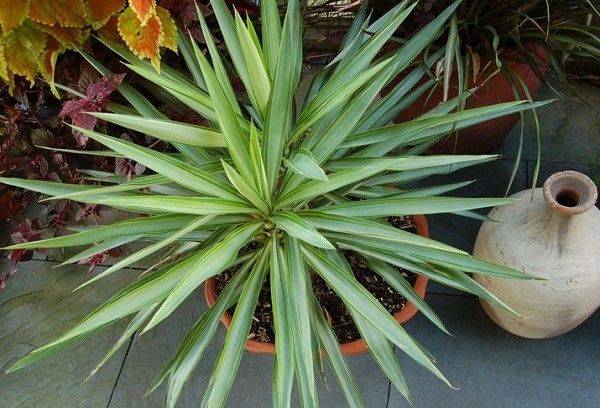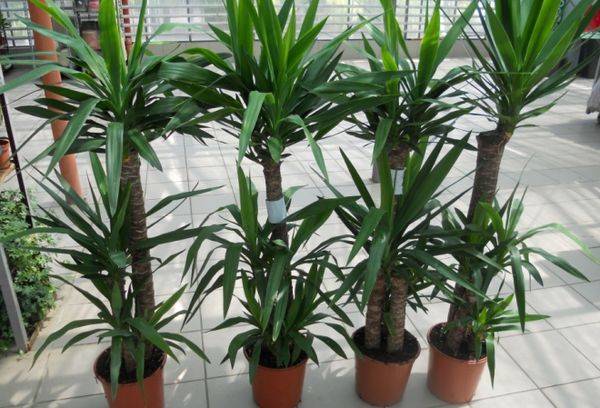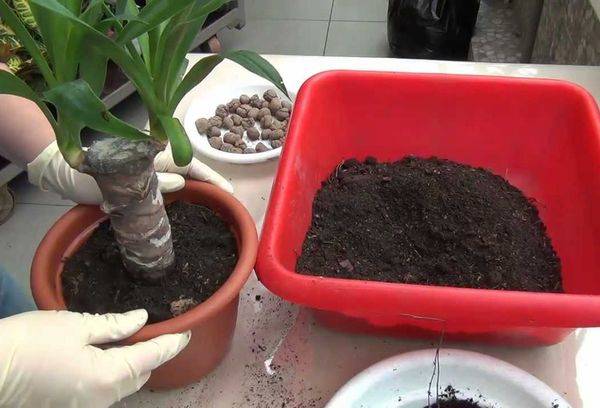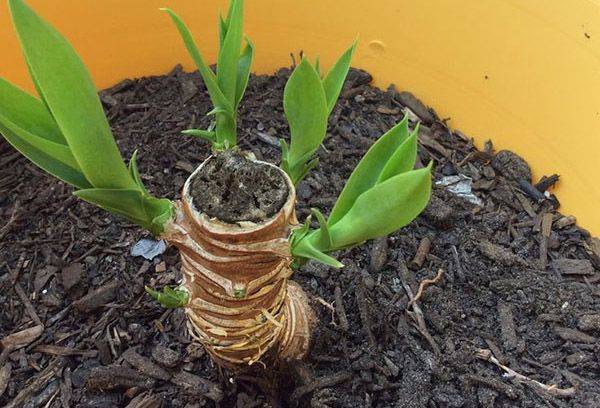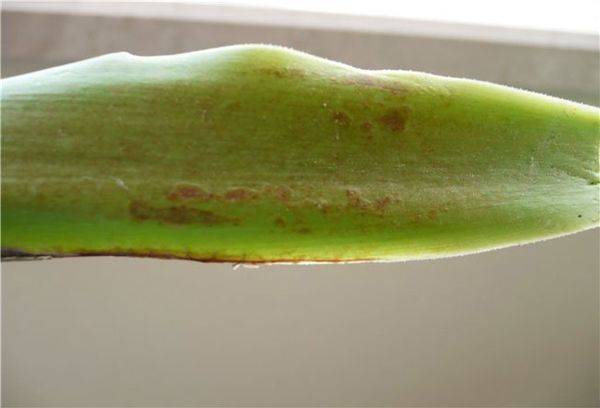Features of caring for indoor yucca
This plant looks very much like a palm tree; it can be called a leader among home and office flowers, and in regions with hot climates it is widely used in landscape design. The beautiful palm-shaped yucca is unpretentious and easy to care for; the gardener humbly tolerates mistakes, as long as there is periodic watering.
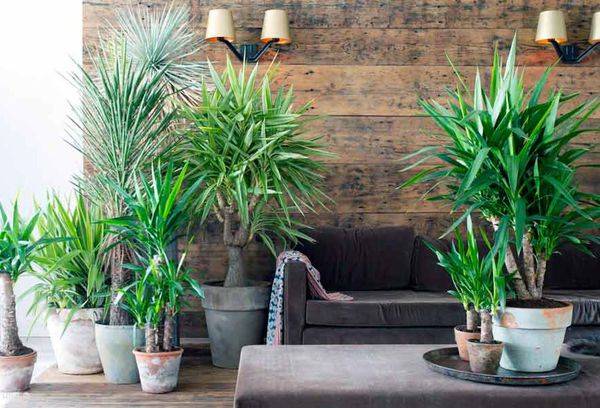
The plant belongs to the asparagus family, or asparagus family, agaraceae class. The tree is evergreen with long, pointed leaves, grouped in ornamental bunches at the top of the trunk. Yucca is most suitable as a decoration for a hall or living room.
It takes a long time to form a large tree because yucca grows very slowly. From May to September it is recommended to keep it outdoors in the garden or on the balcony. The plant should be prepared gradually for sunlight, first placing it in a shaded area. The advantages of yucca include its resistance to dry air in residential areas, which is an important factor.
Varieties
Plant species differ greatly in size and individual details of appearance, but they are all united by spear-shaped leaves. Thanks to this shape of the leaf blade, the plant received the names “Spanish dagger” and “Adam’s needle”.
Aloe yucca (Yucca aloifolia) has a dense rosette of sword-shaped leaves, the length of which reaches 55 cm and the width at the base - 15. The ends of the leaves are strongly pointed, and the edge is serrated. The foliage is dark green with a bluish tint and has a light edge.The tree trunk is pronounced, reluctant to branch, in the wild it reaches a height of 5 m.
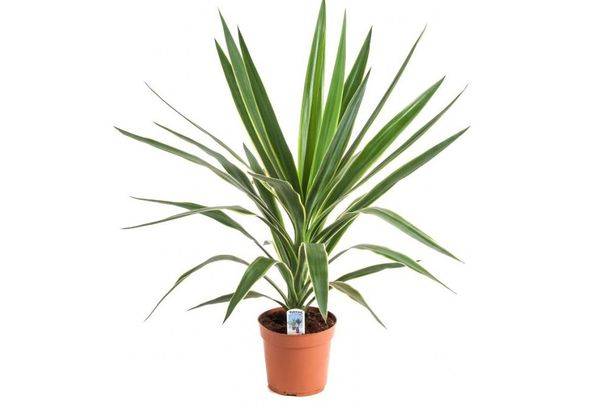
Yucca Pak Copstek
Yucca aloelifolia has been developed in the following varieties:
- Marginata characterized by a whitish edging along the edges of the leaf blade;
- Tricolor has yellow and white stripes on the leaves;
- Quadricolor distinguished by yellow, white and red lines on a green leaf;
- Atkinsii - a low-growing, compact variety with purple foliage.
Giant yucca (Yucca gigantea), or elephant yucca (Yucca elephantipes) is similar in appearance to the previous species, but much larger. In the wild it reaches a height of 8 m. The foliage is dark green, bright, has a glossy coating, with a jagged edge. The ends of the leaf plates are not very sharp, gradually tapering. The leaf length is up to 80 cm, and the width at the base is up to 9 cm.
Able to branch well from the base of the stem. The flowers are white, the inflorescence is up to 1 m long. This is the most popular species grown at home. Giant yucca is available for sale in almost all flower shops, mainly in the form of a tree-like rooted cutting with several leaf rosettes. Gains altitude too slowly. Over the course of several years it grows only one and a half meters.
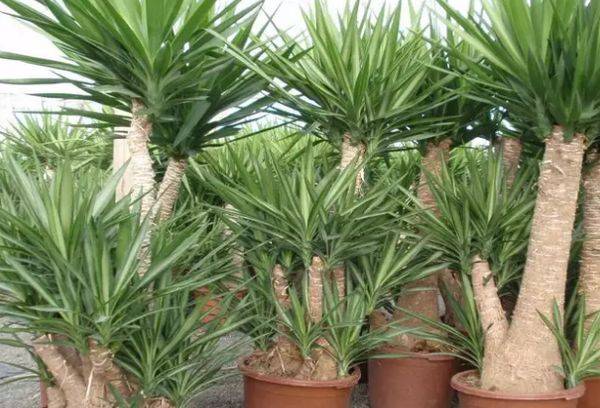
Yucca ivory Jewel
In its historical homeland it has many names. For example, in Guatemala it is called palmera, and the Mexicans call it palmita. In fact, elephant yuccas are similar to palm trees, but have nothing to do with them from a botanical point of view.
There are several varieties of elephant yucca (giant):
- Artola Gold - this variety has a wide longitudinal stripe of creamy, heterogeneous color running along the leaf, in some places having a light green tint;
- Silver Star - the variety is distinguished by a stripe running down the center of the leaf blade, gray-green on the outside and white-green on the inside;
- Jewel - attracts with variegated leaves, darker towards the edges, with a wide longitudinal gray-light green line, along which sometimes there is also a creamy narrow stripe;
- Puck - This is the most common variety, characterized by light green, uniform leaves without a pattern (supplied from the Netherlands).
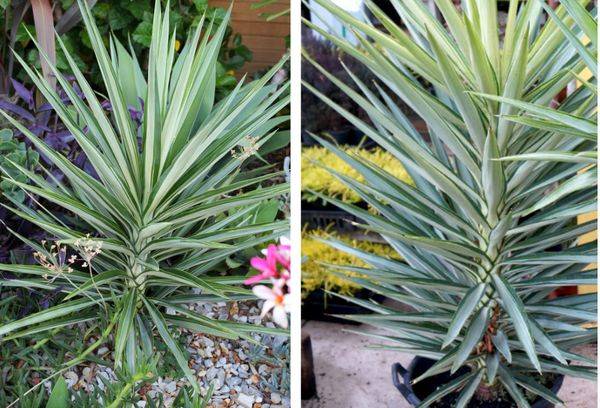
Yucca silver star
Care rules: temperature and light
As mentioned earlier, yucca feels great at home and does not require close attention from the owner.
Temperature regime. Yucca grows wild in sunny locations in subtropical or temperate regions. However, in indoor conditions (in an enclosed space) it cannot tolerate extreme heat. The optimal temperature is 24-25° C (not higher than +30). In winter, relative coolness is desirable, 18-20 degrees Celsius, but if there is a lack of light, it is permissible to lower the temperature to +8. Since from October to March it is difficult to find a cool corner for the yucca in the apartment (heating systems are on), it is enough to place it in a bright place without drafts. The main thing is to provide the tree with protection from the hot air of heating devices and organize additional artificial lighting when little light penetrates from the windows.
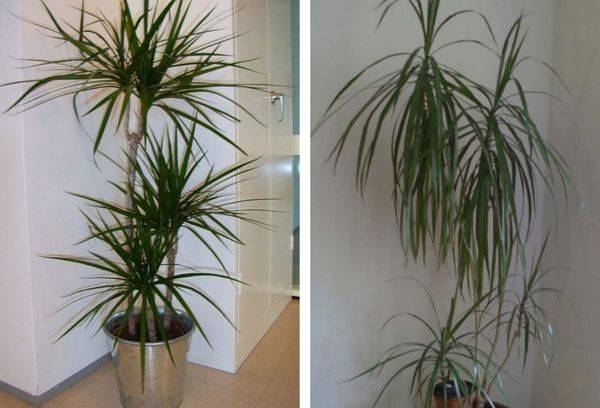
Dracaena carinatum
Light mode. Yucca prefers plenty of sunlight because in the wild it grows in full sun. Small trees are placed on the windowsill of any window. If it faces south or west, partial shade will be needed on very hot, sunny spring days after a long winter.
During the autumn-winter period, the sun is always not enough.If the yucca is located in the back of the room, you need to move it towards the window, placing it not on the floor, but on a table or bedside table (otherwise the crown will be lower than the opening). At the same time, it is important to take care of protecting the tree from the flow of warm air from the battery. If the yucca even leans towards the window opening, this means that the light deficit is not being replenished. In this case, you will have to turn on the phytolamps.
Watering and air humidity
Yucca needs more than moderate soil moisture. If the air temperature is at or above 25° C, then after the top layer of soil has dried, you should wait 2-4 days (based on how hot or cool it is) before watering. With adequate watering, the soil has time to dry by two-thirds. This rule applies all year round. If the tree is surrounded by cool weather (below 25 degrees), moisture is further reduced. When kept in a cold room (15-16° C), for example, on an insulated loggia, very infrequent watering is required.
The time when it is cool outside and the heating has not yet been turned on or has already been turned off is the most dangerous for yucca. During these periods, the tree is surrounded by cold and damp air, and the soil dries out slowly. You need to carefully monitor the condition of the leaves and soil. If you water too often, stagnation of liquid will form and the roots will most likely rot, and in damp, cold climates there is a high risk of stem rot. Overdrying soil for yucca is more beneficial than excess moisture.
Advice
If after 3-4 days the soil has not dried out, do not wait for the effects of waterlogging to appear - loosen the soil, squeeze it with sticks, moving it away from the walls of the pot. A sign that you are overwatering your yucca is the appearance of mushroom flies flying from the surface of the soil.The larvae of these insects develop only with prolonged dampness.
It is not necessary to spray the yucca leaves, but from time to time the plant needs a warm shower to remove dust. In winter, when the central heating is turned on, you need to focus on the level of relative humidity of the surrounding air. If the indicator is below 40%, then you will still have to spray, twice a day, if the parameter is higher, then there is no need for spraying.
How to replant
The most suitable soil for planting yucca is slightly acidic (pH 5.5-6.5), loose, porous and nutritious, containing draining particles. To prepare the soil mixture yourself, use one of two recipes:
- 2 parts leaf soil, 2 parts turf, 1 part humus and 2 parts drainage (small gravel or zeolite);
- 2 parts store-bought universal soil, 1 part small pebbles, 1 part coconut substrate, 1 part rotten compost.
Yucca is usually transplanted in the spring, once every 2 years. Choose a large pot or tub to give the tree stability. The drainage layer should be thick - from 5 cm to a third of the height of the pot. It is recommended to add a little charcoal to the soil.
Top dressing
From April to September, fertilizers are applied once every 2-3 weeks for decorative deciduous indoor plants. First of all, it is necessary to feed plants planted in store-bought soil (about 2 months after planting), since useful substances are consumed from it faster. If the soil mixture is made independently according to a recipe, then fertilizers may not be useful for a year.
Reproduction
Typically, yucca is planted by rooting the crown of the trunk or pieces of the stem approximately 10 cm long. The operation is carried out in the spring. There are two more known methods of reproduction: offspring and seeds.
Cut off the small top of the stem and remove excess leaves from it. The smaller cut part takes root more easily. If the cutting is large, then up to 5 leaves are left on it. Place in cool boiled water with the addition of a piece of charcoal. The water is changed every 3 days. The cutting takes root at a constant temperature of 24-25 degrees.
Not every tree produces children. Using a sharp knife or blade, the daughter rosette is cut from the main trunk. The damaged area on the stem is covered with garden varnish and sprinkled with crushed coal or sulfur. The rosette is placed in damp vermiculite. When the roots appear, the seedling is planted in a pot of soil containing pieces of birch charcoal. Reproduction by offspring is usually carried out in the spring-summer period, since at other times of the year the rosettes take root poorly and for a long time, in addition, there is a high risk of harming the mother tree.
Seeds for propagation of yucca are taken only fresh. They should be soaked for 24 hours in warm water, then sown in a mixture of peat and leaf soil. The container is covered with film or glass and placed in a warm place, ventilated 2 times a day. The germination period is usually one month.
Diseases
The appearance of brown spots on leaves is usually caused by a number of reasons:
- hypothermia or excessive moisture of the roots leads to a fungal infection;
- too dense sticky soil does not dry out well and contributes to hypoxia of the root system;
- poor absorption of nutrients due to inappropriate soil acidity.
Advice
Infected leaves should be removed, the plant should be treated with a fungicide, watering should be adjusted, and spraying should be temporarily stopped.Move the tree to a lighted place.
Rot caused by fungi or bacteria develops rapidly. Symptoms are: softening of the stem and leaves, pale color. In the affected area, the trunk cracks when touched; there is a cavity inside it, sometimes with remains of rot. When the disease is advanced, the leaves turn yellow and droop, and the plant gradually dies. Trunk rot is always associated with excess soil moisture. Sometimes this disease occurs when damp soil with roots is overcooled.
In order to prevent rot, loosening components (sand, zeolite, gravel, etc.) should be added to the soil, the soil must be loosened frequently, watering rules and temperature conditions must be observed.
Rolling yucca leaves into a tube means that the soil is too dry or the air is too dry.
The leaves at the base become yellow or white, and the tree stretches strongly upward - the reason is the lack of light in the autumn-winter period.
By following our simple recommendations, you can easily grow exotic yucca at home.
